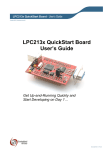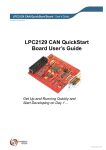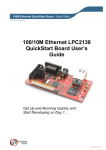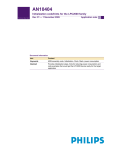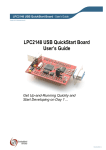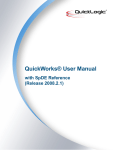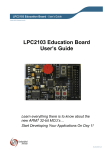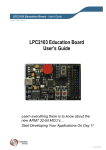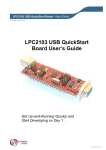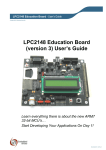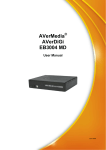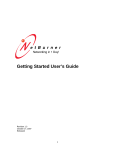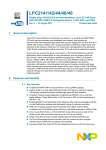Download QuickStart Program Development User`s Guide
Transcript
QuickStart Program Development - User’s Guide Copyright 2005 © Embedded Artists AB QuickStart Program Development User’s Guide Get Up-and-Running Quickly and Start Developing on Day 1… EA2-USG-0509 v1.0 Rev A QuickStart Program Development - User’s Guide Page 2 Embedded Artists AB Friisgatan 33 SE-214 21 Malmö Sweden [email protected] http://www.EmbeddedArtists.com Copyright 2005 © Embedded Artists AB. All rights reserved. No part of this publication may be reproduced, transmitted, transcribed, stored in a retrieval system, or translated into any language or computer language, in any form or by any means, electronic, mechanical, magnetic, optical, chemical, manual or otherwise, without the prior written permission of Embedded Artists AB. Disclaimer Embedded Artists AB makes no representation or warranties with respect to the contents hereof and specifically disclaim any implied warranties or merchantability or fitness for any particular purpose. Information in this publication is subject to change without notice and does not represent a commitment on the part of Embedded Artists AB. Feedback We appreciate any feedback you may have for improvements on this document. Please send your comments to [email protected]. Trademarks InfraBed and ESIC are trademarks of Embedded Artists AB. All other brand and product names mentioned herein are trademarks, services marks, registered trademarks, or registered service marks of their respective owners and should be treated as such. Copyright 2005 © Embedded Artists AB QuickStart Program Development - User’s Guide Page 3 Table of Contents 1 Introduction 1.1 1.1.1 1.2 Low Cost QuickStart Boards 4 Design and Production Services 4 Other QuickStart Boards and Kits 4 2 Getting Started 5 2.1 Test program 5 2.2 Program Download 6 2.2.1 Philips LPC2000 Flash Utility 6 2.2.2 LPC21ISP 7 2.3 Program Development Environment 2.4 Installing the QuickStart Build Environment 3 QuickStart Build Environment 9 10 15 3.1 Makefiles 15 3.2 Startup Framework 18 3.3 GCC 22 4 CD-ROM and Product Registration 23 4.1 CD-ROM 23 4.2 Product Registration 23 5 Further Information Copyright 2005 © Embedded Artists AB 4 24 QuickStart Program Development - User’s Guide Page 4 1 Introduction Thank you for buying a product from Embedded Artists. This document is a User’s Guide that describes how to get started with application program development on day 1 using our QuickStart Build Environment for Philips LPC2xxx family of ARM7 microcontrollers. This document is common for all LPC2xxx QuickStart Boards from Embedded Artists. When buying a QuickStart Board from Embedded Artists, a Resource CD-ROM is always included with the board. This CD is filled with useful information and programs that help you get started immediately with your application development. A number of complete development environments are included, specifically Embedded Artists’ unique QuickStart Build Environment. This document describes how to get started with application development on day 1 using this QuickStart Build Environment. 1.1 Low Cost QuickStart Boards Our QuickStart Boards are very low cost and can be used for prototyping / development as well as for OEM production. Modifications for OEM production can easily be done, even for modest production volumes. Contact Embedded Artists for further information about design and production services. 1.1.1 Design and Production Services Embedded Artists provide design services for custom designs, either completely new or modification to existing boards. Specific peripherals and/or I/O can easily be added to the different designs, for example communication interfaces, specific analogue or digital I/O, and power supplies. Embedded Artists has a broad, and long, experience in designing industrial electronics in general, and specifically with Philips LPC2xxx microcontroller family. Our competence also include wireless and wired communication for embedded systems, such as IEEE802.11b/g (WLAN), Bluetooth™, ZigBee™, ISM RF, Ethernet, CAN, RS485, and Fieldbuses. • Prototype and low-volume production takes place in Sweden for best flexibility and short lead times. • High-volume production takes place in China for lowest possible cost. 1.2 Other QuickStart Boards and Kits Visit Embedded Artists’ home page, www.EmbeddedArtists.com, for information about other QuickStart boards / kits or contact your local distributor. Copyright 2005 © Embedded Artists AB QuickStart Program Development - User’s Guide Page 5 2 Getting Started 2.1 Test program All QuickStart Boards come with a pre-installed test program. The test program is great for verifying that the board really works, and can for example be used if you suspect that the board has been damaged (for some reason). Simple connect a LED to each I/O pin. A running-one pattern will typically present itself on the LEDs. Internal functions, like the Real-Time Clock (RTC) and EEPROM will also be tested (if present) as well as the UART. Connect the QuickStart Board to a terminal program on the PC. A great one is included on the CD.-ROM. The baud rate differs between the QuickStart Boards depending on different crystal clock frequencies. Check with the User’s Manual for the specific QuickStart Board you are using, but in general the baud rate is 115200 bps for 14.7456 MHz crystals and 38400 bps for 12.0000 MHz crystals. 8 data bits, no parity bits, and one stop bit (i.e., 8N1).is typically always used. The test program will output test result information regarding the internal tests on the terminal, for example from the RTC, I2C and E2PROM tests. Also, the UART/RS232 channel can be tested by typing characters in the terminal program. The output from the test program will look something like in Figure 1 below. Observe that the screen shot below is just an example. Every QuickStart Board is unique. Figure 1 – Example Test Program Output Copyright 2005 © Embedded Artists AB QuickStart Program Development - User’s Guide Page 6 2.2 Program Download For now, it is assumed that the program to be downloaded is already developed and there exist a HEX-file to be downloaded. This HEX-file represents the binary image of the application program. There are basically two ways of downloading a program into a LPC2xxx microcontroller: • ISP – In-System Programming The LPC2xxx microcontroller provides on-chip bootloader software that allows programming of the internal flash memory over the serial channel. The bootloader is activated by pulling port pin P0.14 low during reset of the microcontroller. Most QuickStart Boards contains a circuit for automatically controlling pin P0.14 and the reset signal over the RS232 channel. This allows the program download to be fully automated. o Philips provides a utility program for In-System Flash (ISP) programming called LPC2000 Flash Utility. o Alternatively, there is a program called LPC21ISP that can be used. Source code is available. This program also provides a terminal functionality, which can be very helpful when developing your application program. The same serial channel that is used to download the program is typically also used for printing out information from the running program. The program immediately switch to terminal mode after program download and will hence not miss any characters sent on the serial channel directly after program start. The installation files for both programs can be found on the accompanying CDROM. • JTAG For specific information about program download (i.e., Flash programming) with a JTAG interface, consult the manual for the specific JTAG interface that is used (e.g., CrossConnect from Rowley Associates, J-link from Segger, Ulink from Keil, or Wiggler from MacRaigor). Most QuickStart Boards have two jumpers / links that will connect the RS232 channel to the active control over pin P0.14 and the reset signal. See the User’s Manual for the specific QuickStart Board you are using for details. After program download, the jumpers / links can be left connected, or removed if needed. If for example the PC end controls the RS232 signals DTR and/or RTS during normal program execution, then it might be required that the jumpers / links are removed after program download. 2.2.1 Philips LPC2000 Flash Utility Philips LPC2000 Flash Utility program looks like Figure 2 below. Never versions than v2.2.0 may exist when you read this document. Copyright 2005 © Embedded Artists AB QuickStart Program Development - User’s Guide Page 7 Figure 2 – Philips LPC2000 Flash Utility Screenshot Configure the dialog as shown above. The program will control the RS232 signals DTR and RTS if the appropriate checkbox is checked, and hence provide fully automated program download. You can easily test the connection with a QuickStart Board by pressing the Read Device ID button. The text fields for Part ID and Boot Loader ID will then contain uploaded information from the microcontroller. Observe that the XTAL Freq. must be set to appropriate value. For most QuickStart Boards it’s either 14.7456 MHz or 12.0000 MHz. In these cases the value 14746 or 12000 shall be written in the text box. If the crystal frequency has been changed, make sure the appropriate value is set. Set the communication baud rate to 115200 (for 14.7456 MHz crystal) or 38400 (a reliable connection cannot be achieved with higher baud rates if the crystal is 12 MHz). If no connection can be established test with a low Baud Rate, for example 1200 bps. Also verify that the correct COM-port has been selected (under Connected to Port). Select the HEX file to be downloaded and then press the Upload to Flash button. The downloaded program will immediately start after the download (i.e. the Upload to Flash operation is ready) is the option Execute Code after Upload is checked. 2.2.2 LPC21ISP The LPC21ISP program is made publicly available by Martin Maurer. Source code is also available at: http://engelschall.com/~martin/lpc21xx/isp/index.html. Figure 3 below shows the command syntax for the program. Copyright 2005 © Embedded Artists AB QuickStart Program Development - User’s Guide Page 8 Figure 3 – LPC21ISP Portable Command Line ISP Screenshot A typical program download sequence may look like in Figure 4 below. Here, the test program is downloaded. As seen, the first part is the actual program download phase. Then this is done, the program switches to being a terminal (the second part) and the messages from the test program is displayed. It also sends anything typed on the keyboard back to the QuickStart Board. As seen the program ends when ESC is pressed. This sequence illustrates the benefits from using the program as a terminal directly after program download. No characters are missed after program start. Program Download Phase Terminal Phase Figure 4 – LPC21ISP Command Line ISP Download Screenshot Example Copyright 2005 © Embedded Artists AB QuickStart Program Development - User’s Guide Page 9 Another benefit with this program is that it runs under Linux. Use version 1.28, or later, of LPC21ISP.EXE since older versions must be recompiled with increased reset timeout (when the program tries to synchronize to the QuickStart Board). The timeout should be increased to at least 350 ms. 2.3 Program Development Environment There are many options when it comes to the actual application program development. First of all, you must select a development environment, i.e., an editor (preferably with project management capabilities), a compiler package (compiler plus linker), and a debugger. Fortunately, there are many different choices for ARM program development, each with its pros and cons. The list below is far from complete but gives a general overview. The accompanying CD-ROM (see Section 4.1 for more details) contains many of these programs / environments. • QuickStart Build Environment from Embedded Artists Embedded Artists has created a complete GCC build environment for all QuickStart boards. This will ease program development for novel users. By installing the QuickStart Build Environment you will automatically get a complete setup of the build environment. • Rowley Associates CrossWorks for ARM A complete development environment from Rowley Associates, including an editor, project manager, a complete compiler build environment, and a debugger. The version included on the CD is a 30-day fully functional evaluation version. • IAR Embedded Workbench A complete development environment from IAR Systems, including an editor, project manager, a complete compiler build environment, and a debugger. The version shipped on the CD-ROM has a 32 Kbyte program size limit, but is fully functional in all other aspects. • Keil uVision This is another complete development environment, but from Keil. It includes an editor, project manager, a complete compiler build environment, and a debugger. An evaluation version can be downloaded from Keils homepage. One version of the development environment is based on the GCC compiler (currently version 3.3.1 of GCC) and a later version is based on Keils own compiler. • Programmers notepad This is a very good editor and project manager that is increasing in popularity. The program can easily be integrated with the GCC compiler. • Eclipse + CDT This is a very good development environment (editor and project manager) with specific support for C/C++ code development. It does not contain a compiler but can easily be connected to one, for example GCC. • GCC distribution GNUARM A complete distribution of GCC, specifically for ARM processors. Current version of GCC is 3.4.3 and the new 4.0.0, and it is constantly updated. • WinARM This is another distribution that not only contains GCC but also Programmers Notepad, LPC21ISP, a terminal program, and JTAG drivers. Copyright 2005 © Embedded Artists AB QuickStart Program Development - User’s Guide Page 10 2.4 Installing the QuickStart Build Environment This section describes the necessary steps of program installation that is needed to get the QuickStart Build Environment ready for your use. • Copyright 2005 © Embedded Artists AB Start with installing the GNUARM distribution that is included in the CD-ROM. The current version of the file is called: bu-2.15_gcc-3.4.3-c-c++-java_nl1.12.0_gi-6.1.exe. There is also a newer, but less well tested, version (based on GCC v4.0). Only use this newer version if you are an experienced user. The installation is very simple and straightforward. It’s just following the default installation steps as illustrated in the pictures below: QuickStart Program Development - User’s Guide Page 11 Use the default installation directory If you want to save space on your harddisk, you can deseclect the Big Endian component. Copyright 2005 © Embedded Artists AB QuickStart Program Development - User’s Guide Page 12 Install the Cygwin DLLs. Copyright 2005 © Embedded Artists AB QuickStart Program Development - User’s Guide • Copyright 2005 © Embedded Artists AB Page 13 Now install the LPC2xxx-gcc-newlib_vX_X_X_X QuickStart Build Environment (vX_X_X_X is the current version of the file). The installation is also in this case very simple and straightforward. Just follow the default installation steps. QuickStart Program Development - User’s Guide Page 14 Use the default installation directory Observe that if the compiler is not installed on the default location (c:/Program/GNUARM/) the new path must be set in the files build.sh and build_environment.sh. Both files can be found in: C:\Program\InfraBed\evboards\LPC2xxx-gcc-newlib-vX_X_X_X\bin). It is the variable COMPILERDIR2 that must be set (can be found on line 13 in both files). The compiler path must be to the GNUARM/bin directory. Observe that the path above must contain the correct version number instead of …vX_X_X_X\bin. It may for example be: …v2_2_0_0\bin. Copyright 2005 © Embedded Artists AB QuickStart Program Development - User’s Guide Page 15 3 QuickStart Build Environment The QuickStart Build Environment is a complete build environment for GCC including program downloading via ISP. The build environment is built around a bash script. This script sets up all necessary paths. When installing the QuickStart Build Environment you will automatically get shortcuts to this bash script. A practical feature is that there can be different scripts for different hardware platforms, for controlling different hardware specific details of the platforms. There can also be many different compilers (including different versions of the same compiler) without conflicting with each other. The use of the bash script is optional but is recommended for non-experienced users. A typical project has two subdirectories; build_files and startup. Figure 5 below illustrate the general structure. Figure 5 – Typical Project Directory Structure 3.1 Makefiles The subdirectory build_files contains a general makefile and linker script files. The subdirectory startup contains a configurable startup framework for QuickStart Board projects. The startup files form a library that is linked to the main application. The makefiles have a hierarchical structure. Each project, either an executable program file or a library, has a simple makefile that just describe the specifics of the project. This simple makefile includes the general makefile that is placed in the build_files subdirectory. Figure 6 below illustrates the simple makefile. The example comes from the startup library, found under the startup subdirectory. The name of the resulting library is libea_startup_thumb.a. Two C-source code files are listed: consol.c and framework.c. An assembler file called startup.S is also included in the library. ########################################################## # # General makefile for building executable programs and # libraries for Embedded Artists' QuickStart Boards. # (C) 2001-2005 Embedded Artists AB # Name ########################################################## of resulting library. # Name of target (executable program or library) NAME = libea_startup_thumb # Link program to RAM or ROM (possible values for LD_RAMROM is RAM or ROM, # if not specified = ROM) LD_RAMROM = ROM # # # # # # # # # # # Name if specific CPU used (used by linker scripts to define correct memory map) Valid CPUs are: LPC2101, LPC2102, LPC2103, LPC2104, LPC2105, LPC2106 LPC2114, LPC2119 LPC2124, LPC2129 LPC2131, LPC2132, LPC2134, LPC2136, LPC2138 LPC2141, LPC2142, LPC2144, LPC2146, LPC2148 LPC2194 LPC2210, LPC2220, LPC2212, LPC2214, LPC2290, LPC2292, LPC2294 If you have a new version not specified above, just select one of the old versions with the same memory map. Copyright 2005 © Embedded Artists AB QuickStart Program Development - User’s Guide Page 16 CPU_VARIANT = LPC2132 # It is possible to override the automatic linker file selection with the variable below. # No not use this opion unless you have very specific needs. #LD_SCRIPT = build_files/myOwnLinkScript_rom.ld #LD_SCRIPT_PATH = # ELF-file contains debug information, or not # (possible values for DEBUG are 0 or 1) # Extra debug flags can be specified in DBFLAGS DEBUG = 1 #DBFLAGS = # Optimization setting # (-Os for small code size, -O2 for speed) OFLAGS = -Os # Extra general flags # For example, compile for ARM / THUMB interworking (EFLAGS = -mthumb-interwork) EFLAGS = -mthumb-interwork # Program code run in ARM or THUMB mode # Can be [ARM | THUMB] CODE = ARM # List C source files here. CSRCS = consol.c \ framework.c # List assembler source files here ASRCS = startup.S # List subdirectories to recursively invoke make in SUBDIRS = The files are compiled in ARM mode with THUMB interworking (see EFLAGS). List all included C files. List all included assembler files. # List additional libraries to link with LIBS = # Add include search path for startup files, and other include directories INC = -I. # Select if an executable program or a library shall be created #PROGRAM_MK = true LIBRARY_MK = true Select whether # Output format on hex file (if making a program); HEX_FORMAT = ihex an executable program file or a library shall be can be [srec | ihex] created. One of the lines is commented out. # Program to download executable program file into microcontroller's FLASH DOWNLOAD = lpc21isp.exe # Configurations for download program # Which com-pot that is used, which download speed and what crystal frequency on the board. DL_COMPORT = com1 Include the general makefile here. DL_BAUDRATE = 115200 DL_CRYSTAL = 14746 ####################################################################### include ../build_files/general.mk ####################################################################### Figure 6 – Example QuickStart Build Environment Makefile from Startup Library As seen in Figure 6 above the makefile ends with the command: include ../build_files/general.mk. This is a general make file that is part of the complete build environment. This part contains all specific details of compiler and linker invocation. Also at the end, the target must be decided; either an executable program or a library. Either PROGRAM_MK or LIBRARY_MK must be set to true. Copyright 2005 © Embedded Artists AB QuickStart Program Development - User’s Guide Page 17 The example makefile above is quite simple to its structure. It is possible to create more complex project structures that contain many subprojects. A typical example is to have an application project in a root folder. Under this root folder a number of subdirectories exist containing different blocks of functionality. For example, this can be a Real-Time Operating System and a TCP/IP stack. This calls for a recursive makefile structure. The makefile in the root filer will create an executable program. It also includes the makefile in each of the subdirectories. The makefiles that exist in subdirectories will create libraries. An example of a root make file is presented in Figure 7 below. ########################################################## # # General makefile for building executable programs and # libraries for Embedded Artists' QuickStart Boards. # (C) 2001-2005 Embedded Artists AB # Name ########################################################## of resulting program file. # Name of target (executable program or library) NAME = testprogram_10m_eth # Link program to RAM or ROM (possible values for LD_RAMROM is RAM or ROM, # if not specified = ROM) LD_RAMROM = ROM # Name if specific CPU used (used by linker scripts to define correct memory map) # Valid CPUs are: LPC2101, LPC2102, LPC2103, LPC2104, LPC2105, LPC2106 # LPC2114, LPC2119 # LPC2124, LPC2129 # LPC2131, LPC2132, LPC2134, LPC2136, LPC2138 # LPC2141, LPC2142, LPC2144, LPC2146, LPC2148 # LPC2194 # LPC2210, LPC2220, LPC2212, LPC2214, # LPC2290, LPC2292, LPC2294 # If you have a new version not specified above, just select one of the old # versions with the same memory map. CPU_VARIANT = LPC2132 # It is possible to override the automatic linker file selection with the variable below. # No not use this opion unless you have very specific needs. #LD_SCRIPT = build_files/myOwnLinkScript_rom.ld #LD_SCRIPT_PATH = # ELF-file contains debug information, or not # (possible values for DEBUG are 0 or 1) # Extra debug flags can be specified in DBFLAGS DEBUG = 1 #DBFLAGS = Custom linker scripts can be used, but not in this makefile. # Optimization setting # (-Os for small code size, -O2 for speed) OFLAGS = -Os # Extra general flags # For example, compile for ARM / THUMB interworking (EFLAGS = -mthumb-interwork) EFLAGS = # Program code run in ARM or THUMB mode # Can be [ARM | THUMB] CODE = THUMB # List C source files here. CSRCS = main.c # List assembler source files here ASRCS = # List subdirectories to recursively invoke make in SUBDIRS = startup \ tcpip \ pre_emptive_os Copyright 2005 © Embedded Artists AB The files are compiled in THUMB mode. The root folder only contains one file, the main-file. Three different subdirectories that contains different blocks of functions in the final application. QuickStart Program Development - User’s Guide # List additional libraries to link with LIBS = startup/libea_startup_thumb.a \ tcpip/tcpip.a \ pre_emptive_os/pre_emptive_os.a Page 18 The three libraries that are created in the recursive invocation of make are included in the final application. Note the startup library. # Add include search path for startup files, and other include directories INC = -I./startup # Select if an executable program or a library shall be created PROGRAM_MK = true #LIBRARY_MK = true # Output format on hex file (if making a program); can be [srec | ihex] HEX_FORMAT = ihex # Program to download executable program file into microcontroller's FLASH DOWNLOAD = lpc21isp.exe # Configurations for download program # Which com-pot that is used, which download speed and what crystal frequency on the board. DL_COMPORT = com1 DL_BAUDRATE = 115200 DL_CRYSTAL = 14746 ####################################################################### include build_files/general.mk ####################################################################### Figure 7 – Example Root Makefile and Recursive Invocation To build the application program, start a command prompt (the bash script), change directory to the project root, and type: make. Depending on the make file content, either an executable program or a library will be created. To also download the executable program, type: make deploy instead of just make. A final note about the make file; make clean will erase all object files and make depend will recreate dependency files (this is also always done when typing just make). Finally, make terminal will just start the terminal function in the download program (lpc21isp). The specific settings for using the ISP download program can be set with the DL_XXX variables (as seen at the end of Figure 7 above). 3.2 Startup Framework As already mentioned, the startup files form a configurable startup framework. This is often called a Board Support package or BSP for short. It contains the very basic startup and initialization code as well as a console with printf()- and scanf()-like functionality. The BSP is very configurable and can be changed according to your specific needs. Each project can have its specific settings. The configuration file is listed in Figure 8 below, and can be found in file config.h in the startup subdirectory. /****************************************************************************** * * Copyright: * (C) 2000 - 2005 Embedded Artists AB * * Description: * Framework for ARM7 processor * *****************************************************************************/ #ifndef _config_h_ #define _config_h_ /****************************************************************************** * Defines, macros, and typedefs *****************************************************************************/ #define FOSC 14745600 /* External clock input frequency (must be between 10 MHz and 25 MHz) */ Copyright 2005 © Embedded Artists AB QuickStart Program Development - User’s Guide Page 19 #define USE_PLL 1 /* 0 = do not use on-chip PLL, 1 = use on-chip PLL) */ /* PLL multiplication factor (1 to 32) */ /* PLL division factor (1, 2, 4, or 8) */ /* Peripheral bus speed divider (1, 2, or 4) */ #define PLL_MUL 4 #define PLL_DIV 2 #define PBSD 4 /* initialize the MAM (Memory Accelerator Module) */ #if USE_PLL == 1 #define CORE_FREQ (FOSC * PLL_MUL) #else #define CORE_FREQ (FOSC) #endif #if CORE_FREQ < 20000000 #define MAM_TIMING 1 #elif CORE_FREQ < 40000000 #define MAM_TIMING 2 #else #define MAM_TIMING 3 #endif /* number of CCLK to read from the FLASH */ /* number of CCLK to read from the FLASH */ /* number of CCLK to read from the FLASH */ #define MAM_SETTING 2 /* 0=disabled, 1=partly enabled (enabled for code prefetch, but not for data), 2=fully enabled */ #define IRQ_HANDLER 1 /* 0 = Jump to common IRQ handler 1 = Load vector directly from VIC, i.e., LDR PC,[PC,#-0xFF0] */ /* initialize the exception vector mapping */ #ifndef RAM_EXEC #define MAM_MAP 1 /* 1 = exception vectors are in FLASH at 0x0000 0000, 2 = exception vectors are in SRAM at 0x4000 0000 */ #else #define MAM_MAP 2 /* When exec. from RAM, MAM_MAP should always be 2 */ #endif /* setup stack sizes */ #define stackSize_SYS #define stackSize_SVC #define stackSize_UND #define stackSize_ABT #define stackSize_IRQ #define stackSize_FIQ 600 64 64 64 600 64 /* define consol settings */ #define CONSOL_UART 0 #define CONSOL_BITRATE 115200 #define CONSOL_STARTUP_DELAY #define CONSOL_STARTUP_DELAY_LENGTH 100 #define USE_NEWLIB 0 #define CONSOLE_API_PRINTF 1 #define CONSOLE_API_SCANF 0 /* define SRAM size */ #ifdef LPC2101 #define SRAM_SIZE (2 * 1024) #elif defined (LPC2102) #define SRAM_SIZE (4 * 1024) #elif defined (LPC2103) #define SRAM_SIZE (8 * 1024) #elif defined (LPC2104) #define SRAM_SIZE (16 * 1024) #elif defined (LPC2105) Copyright 2005 © Embedded Artists AB /* Short startup delay in order to remove risk for false startbit detection, timer #1 will be used in polled mode */ /* 100 us is slightly more than one character at 115200 bps */ /* 0 = do not use newlib (= save about 22k FLASH), 1 = use newlib = full implementation of printf(), scanf(), and malloc() */ /* 0 = printf() = sendString, 1 = simple, own implementation of printf() */ /* 0 = none, 1 = simple, own implementation of scanf() */ /* LPC2101 */ /* LPC2102 */ /* LPC2103 */ /* LPC2104 */ QuickStart Program Development - User’s Guide #define SRAM_SIZE (32 * 1024) #elif defined (LPC2106) #define SRAM_SIZE (64 * 1024) #elif defined (LPC2114) #define SRAM_SIZE (16 * #elif defined (LPC2124) #define SRAM_SIZE (16 * #elif defined (LPC2119) #define SRAM_SIZE (16 * #elif defined (LPC2129) #define SRAM_SIZE (16 * /* LPC2105 */ /* LPC2106 */ 1024) /* LPC2114 */ 1024) /* LPC2124 */ 1024) /* LPC2119 */ 1024) /* LPC2129 */ #elif defined (LPC2131) #define SRAM_SIZE (8 * 1024) #elif defined (LPC2132) #define SRAM_SIZE (16 * 1024) #elif defined (LPC2134) #define SRAM_SIZE (16 * 1024) #elif defined (LPC2136) #define SRAM_SIZE (32 * 1024) #elif defined (LPC2138) #define SRAM_SIZE (32 * 1024) #elif defined (LPC2141) #define SRAM_SIZE (8 * 1024) #elif defined (LPC2142) #define SRAM_SIZE (16 * 1024) #elif defined (LPC2144) #define SRAM_SIZE (16 * 1024) #elif defined (LPC2146) #define SRAM_SIZE (32 * 1024) #elif defined (LPC2148) #define SRAM_SIZE (32 * 1024) #elif defined (LPC2194) #define SRAM_SIZE (16 * 1024) #elif defined (LPC2210) #define SRAM_SIZE (16 * #elif defined (LPC2220) #define SRAM_SIZE (64 * elif defined (LPC2212) #define SRAM_SIZE (16 * #elif defined (LPC2214) #define SRAM_SIZE (16 * #elif defined (LPC2290) #define SRAM_SIZE (16 * #elif defined (LPC2292) #define SRAM_SIZE (16 * #elif defined (LPC2294) #define SRAM_SIZE (16 * Page 20 /* LPC2131 */ /* LPC2132 */ /* LPC2134 */ /* LPC2136 */ /* LPC2138 */ /* LPC2141 */ /* LPC2142 */ /* LPC2144 */ /* LPC2146 */ /* LPC2148 */ /* LPC2194 */ 1024) /* LPC2210 */ 1024) /* LPC2220 */ 1024) /* LPC2212 */ 1024) /* LPC2214 */ 1024) /* LPC2290 */ 1024) /* LPC2292 */ 1024) /* LPC2294 */ #else #error CPU_VARIANT not defined in the makefile, or illegal value #endif #define #define #define #define SRAM_SADDR SRAM_TOP SRAM_EADDR STK_SIZE #define STK_SADDR #endif 0x40000000 /* SRAM starting address */ (SRAM_SADDR+SRAM_SIZE) /* SRAM end address + 1 */ (SRAM_SADDR+SRAM_SIZE-1) /* SRAM end address */ (stackSize_SYS+stackSize_SVC+stackSize_UND+ stackSize_ABT+stackSize_IRQ+stackSize_FIQ) (SRAM_EADDR+1-STK_SIZE) /* Stack start address */ /* _config_h_ */ Figure 8 – Board Support Package (BSP) Configuration File There are three versions of the consol in order to best fit different situations: • Copyright 2005 © Embedded Artists AB A very simple version that basically only supports printing strings (without any formatting parts) and printing numbers (decimal or hexadecimal). QuickStart Program Development - User’s Guide Page 21 • A simple printf() implementation that supports the simplest formatting tags. The implementation has been designed for lest possible stack usage (about 40 bytes). • A full ANSI printf() implementation from newlib (part of the compiler environment that comes with GNUARM). This routine requires about 600 bytes of stack space and should normally not be used in resource constraint systems. The code size for the first two alternatives is minimal (about 2k in program size for the entire framework). When using printf() from newlib, the code size is about 30 k for the entire framework (including a large part of the newlib library). Just edit the configuration file above and recompile your project. The recursive nature of the makefiles will make sure that the startup library is recompiled and linked with the final executable program. You can find an example project under the QuickStart Build Environment installation. See Figure 9 below for the path. It is typically: c:/program/InfraBed/evboards/LPC2xxx-gcc-newlib-vX_X_X_X. The beginning of the path can be specific for your installation and the ending of the path is specific for the version of the build environment. The figure below illustrates version 2_0_0_0. Your version may be different. Figure 9 – Sample Project Files under QuickStart Build Environment Installation The startup framework (BSP) is very simple and can best be understood by studying the source code files. If using the console functionality (printf()- and scanf()-like functions) observe that the function eaInit() must be called before printf() and the console can be used. The following code segment illustrates this. #include <ea_init.h> ... ... int main(void) { eaInit(); //Now, the console/printf can be used ... } Also observe that whenever the BSP printf() should be used, the following include file must be included into the source code file. #include <printf_P.h> Copyright 2005 © Embedded Artists AB QuickStart Program Development - User’s Guide Page 22 As a summary; Embedded Artists’ QuickStart Build Environment is comprised of: • A make build environment, controlled by bash script. A program or library build is started via the command: make. • A program download feature, by using the LPC21ISP program. A program build and download is started via the command: make deploy. • A Board Support Package (BSP) with startup code and console functions (i.e., printf() and scanf()-like functionality). 3.3 GCC This will be very similar to the QuickStart Build Environment example, except that you will have to set up all paths manually and create your own startup files. The make files will also be a bit more complex. An example makefile is presented in Figure 10 below. Much more complex examples than the makefile below also exist. # # Example makefile that creates a program called ‘test’, containing the # C-source code files: main.c, eeprom.c, and i2c.c plus the assembler # file startup.S # LIBS DEBUG CFLAGS INCLUDE ARMCC OBJS LDFLAGS = = = = = = = -g -Wall -nostartfiles -mthumb-interwork –mthumb -Iinc/ -Iinc/specific/ #specify include paths here arm-elf-gcc main.o eeprom.o i2c.o startup.o -Wl,-Trom.ld #this file controls the linker all: test.hex test: $(OBJS) arm-elf-gcc $(CFLAGS) $(LDFLAGS) $(OBJS) $(LIBS) -o test.elf %.o: %.c arm-elf-gcc -c $(INCLUDE) $(CFLAGS) $< %.o: %.S arm-elf-gcc -c $(INCLUDE) $(CFLAGS) $< %.o: %.c arm-elf-gcc -c $(INCLUDE) $(CFLAGS) $< %.hex: % arm-elf-objcopy -O ihex $<.elf $@ clean: rm -f *.o test.elf test.hex Figure 10 – Example GCC Makefile Copyright 2005 © Embedded Artists AB QuickStart Program Development - User’s Guide Page 23 4 CD-ROM and Product Registration The CD-ROM accompanying all QuickStart Boards contains a lot of information and programs that will QuickStart your program development! Observe that there may be newer versions of different documents and programs available than the ones on the CD-ROM. See Section 4.2 for information about the product registration process, which allows you to always have access to the latest versions. 4.1 CD-ROM The following is included on the CD-ROM: • The preloaded test program as a HEX-file. • The two different ISP download programs. • Datasheets of all circuits on the QuickStart Board. • QuickStart Build Environment from Embedded Artists, which contains a complete setup of a build environment for GCC. • A complete development environment: Rowley Associates CrossWorks for ARM, 30-day evaluation version. • A complete development environment: IAR Embedded Workbench for ARM, Kickstart Edition with 32 Kbyte program size limit. • Another complete development environment: GCC, GNUARM distribution, including compiler, linker, make, and debugger. • The program Programmers Notepad, which is a very good program development editor and project manager. • The Eclipse development environment including the CDT (C/C++ Development Tools) project. 4.2 Product Registration By registering as a customer of Embedded Artists you will get access to more valuable material that will get you up-and-running instantly: • Access to a Real-Time Operating System (RTOS), in the form of a library that can be used for non-commercial applications. • Access to over 20 sample applications that demonstrates different (peripheral) functions in the LPC2xxx processor. • Access to the latest versions of all information and programs on the CD-ROM. Registering is easy and done quickly. 1) Go to http://www.EmbeddedArtists.com, select Support and then Register. 2) Type in the products serial number (can be found on the QuickStart Board or on the package carrying the board) along with your personal information. Copyright 2005 © Embedded Artists AB QuickStart Program Development - User’s Guide Page 24 5 Further Information The LPC2xxx microcontroller is a complex circuit and there exist a number of other documents with a lot more information. The following documents are recommended as a complement to this document. [1] Philips LPC2xxx Datasheet [2] Philips LPC2xxx User’s Manual [3] Philips LPC2xxx Errata Sheet [4] ARM7TDMI Technical Reference Manual. Document identity: DDI0029G http://www.arm.com/pdfs/DDI0029G_7TDMI_R3_trm.pdf [5] ARM Architecture Reference Manual. Document identity: DDI0100E Book, Second Edition, edited by David Seal, Addison-Wesley: ISBN 0-201-73719-1 Also available in PDF form on the ARM Technical Publications CD [6] ARM System Developer’s Guide – Designing and Optimizing System Software, by A.N. Sloss, D Symes, C. Wright. Elsevier: ISBN 1-55860-874-5 [7] Embedded System Design on a Shoestring, by Lewin Edwards. Newnes: ISBN 0750676094. [8] GNU Manuals http://www.gnu.org/manual/ [9] GNU ARM tool chain for Cygwin http://www.gnuarm.com [10] An Introduction to the GNU Compiler and Linker, by Bill Gatliff http://www.billgatliff.com [11] LPC2000 Yahoo Group. A discussion forum dedicated entirely to the Philips LPC2xxx series of microcontrollers. http://groups.yahoo.com/group/lpc2000/ [12] The Insider’s Guide to the Philips ARM7-Based Microcontrollers, by Trevor Martin. http://www.hitex.co.uk/arm/lpc2000book/index.html Observe that there can be newer versions of the documents than the ones linked to here. Always check for the latest information / version. Copyright 2005 © Embedded Artists AB
























